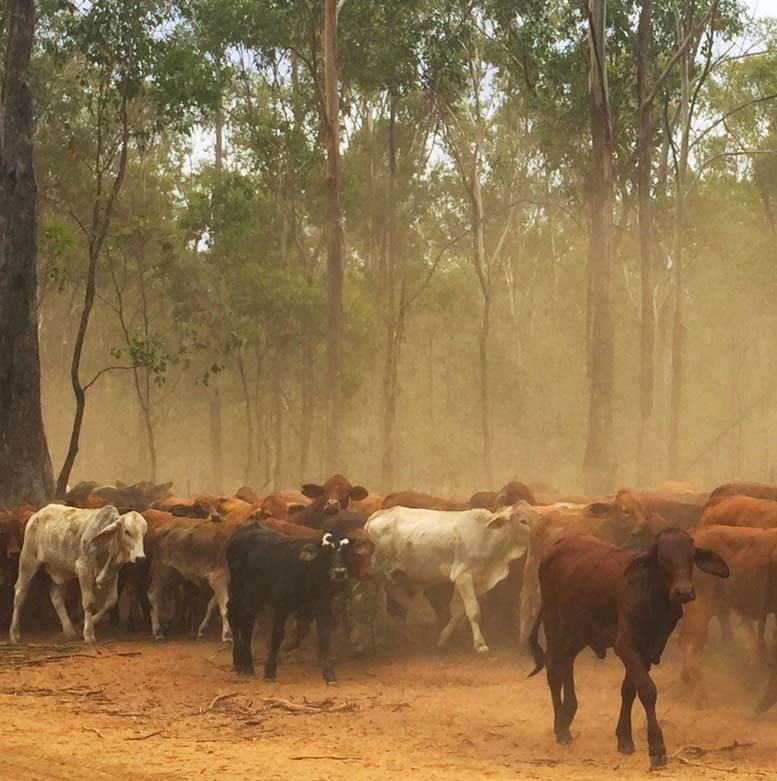Did you know that regulated vegetation (Category B, Category C, Category R) on your property can still be thinned under Queensland’s vegetation management framework?
Thinning vegetation in Category B requires a Development Approval process under the State Development Assessment Provisions, including:
- A Relevant Purposes Application Form under the Vegetation Management Act 1999 (VMA)
- An application fee of $3,373 (as of October 2020)
- Evidence that the vegetation is thickened, including:
- On ground tree counts and
- A comparison site of the same ecosystem that is not thickened
- Responding to performance outcomes under SDAP State code 16: Native vegetation clearing; including
- Wetlands buffers
- Watercourse buffers
- Mechanical thinning on slopes greater than 5%
- Acid sulphate soils
- Maintaining the floristic composition of the vegetation
- Maps of location and extent of the proposed clearing activities
Thinning vegetation in Category C and Category R (regulated regrowth) areas requires notification to NRME including:
- The regional ecosystems that will be thinned
- Maps showing the location of the thinning area
- Records of pre-clearance photographs and GPS coordinates for potential submission to NRME
- Compliance with the Managing regulated regrowth vegetation accepted development vegetation clearing code including:
- Retaining wetlands and riparian protection zones
- Avoiding steep slopes
- Avoiding mature and habitat trees.
Thinning of vegetation can only occur within regional ecosystems listed in the table at the end of this post.
What is possible under the code:
- Clearing native plants that are not normally associated with a vegetation community – like black wattle infestations
- Thinning vegetation to a rate based on the regional ecosystem type of your property (e.g. 200, 300 or 500 trees per hectare)
What is not possible under the code:
- Thinning vegetation by use of a chain
- Thinning for the sole purpose of grazing, thinning needs to be for the purpose of restoring vegetation to its original floristic composition
- Clearing of any mature or habitat trees
DNRME managing regulated regrowth code: https://www.dnrme.qld.gov.au/__data/assets/pdf_file/0009/1446912/managing-regulated-regrowth-code.pdf
DNRME find out what regulated vegetation is mapped on your property: https://www.dnrme.qld.gov.au/qld/environment/land/vegetation/vegetation-map-request-form
Video tutorial for how to measure tree density:
https://www.youtube.com/watch?v=vhFeURBGXFA
Ecosure can help you through the application processes for thinning, for further details you can call Geoffrey Sinclair or Kade Slater on 07 4994 1000, or email us at admin@ecosure.com.au.
List of regional ecosystems that can be thinned.
| Bioregion | Regional Ecosystems |
| North West Highlands | 1.3.4, 1.5.14, 1.5.2, 1.5.6 |
| Gulf Plains | 2.3.10, 2.3.11, 2.3.15, 2.3.17, 2.3.18, 2.3.19, 2.3.20, 2.3.21, 2.3.22, 2.3.24, 2.3.27, 2.3.29, 2.3.30, 2.3.34, 2.3.36, 2.3.5, 2.3.7, 2.3.9, 2.5.1, 2.5.10, 2.5.12, 2.5.14, 2.5.16, 2.5.2, 2.5.4, 2.5.5, 2.5.9, 2.7.4, 2.7.5, 2.9.4, 2.9.6, 2.10.1, 2.10.2, 2.10.4, 2.10.6, 2.11.1, 2.12.1 |
| Cape York Peninsula | 3.3.16, 3.3.20, 3.3.24, 3.3.28, 3.3.37, 3.3.8, 3.5.24, 3.5.25, 3.5.5, 3.5.6, 3.7.3, 3.9.2, 3.9.4, 3.9.5, 3.9.6, 3.9.7, 3.10.15, 3.11.12, 3.11.13, 3.11.15, 3.11.17, 3.11.7, 3.12.10, 3.12.11, 3.12.18 |
| Mitchell Grass Downs | 4.3.8, 4.3.9, 4.3.10, 4.5.2, 4.5.4, 4.5.8, 4.5.8, 4.5.9, 4.7.4, 4.9.10, 4.9.11, 4.9.12, 4.9.14, 4.9.16, 4.9.18, 4.9.6 |
| Channel Country | 5.5.1, 5.5.2, 5.5.3, 5.5.4, 5.5.6, 5.6.2, 5.6.3, 5.6.4, 5.9.2 |
| Mulga Country | 6.3.16, 6.3.18, 6.3.21, 6.3.22, 6.3.24, 6.3.5, 6.3.7, 6.3.9, 6.5.1, 6.5.10, 6.5.11, 6.5.13, 6.5.14, 6.5.15, 6.5.16, 6.5.17, 6.5.18, 6.5.19, 6.5.2, 6.5.3, 6.5.6, 6.5.7, 6.5.8, 6.5.9, 6.6.1, 6.6.2, 6.7.1, 6.7.10, 6.7.11, 6.7.12, 6.7.13, 6.7.14, 6.7.15, 6.7.16, 6.7.17, 6.7.2, 6.7.6, 6.7.7, 6.7.9, 6.9.2 |
| Wet Tropics | 7.12.28 |
| Central Queensland Coast | 8.5.3, 8.5.5, 8.9.1, 8.11.1, 8.12.12, 8.12.20, 8.12.22, 8.12.6, 8.12.9 |
| Einasleigh Uplands | 9.3.15, 9.3.16, 9.3.19, 9.3.2, 9.3.20, 9.3.21, 9.3.22, 9.3.3, 9.3.5, 9.3.6, 9.3.8, 9.5.10, 9.5.13, 9.5.14, 9.5.3, 9.5.4, 9.5.6, 9.5.7, 9.5.8, 9.5.9, 9.7.1, 9.7.1, 9.7.2, 9.7.3, 9.7.5, 9.8.1, 9.8.11, 9.8.2, 9.8.4, 9.8.9, 9.10.7, 9.11.1, 9.11.13, 9.11.15, 9.11.16, 9.11.17, 9.11.19, 9.11.2, 9.11.22, 9.11.23, 9.11.24, 9.11.25, 9.11.26, 9.11.3, 9.11.31, 9.11.32, 9.11.5, 9.11.7, 9.11.21, 9.12.1, 9.12.10, 9.12.11, 9.12.12, 9.12.13, 9.12.14, 9.12.15, 9.12.16, 9.12.21, 9.12.23, 9.12.24, 9.12.26, 9.12.27, 9.12.28, 9.12.29, 9.12.31, 9.12.32, 9.12.33, 9.12.39, 9.12.4, 9.12.40, 9.12.6, 9.12.7 |
| Desert Uplands | 10.3.10, 10.3.11, 10.3.12, 10.3.14, 10.3.26, 10.3.27, 10.3.28, 10.3.6, 10.3.9, 10.5.12, 10.5.4, 10.5.5, 10.5.9, 10.9.5 |
| Brigalow Belt | 11.3.10, 11.3.12, 11.3.14, 11.3.18, 11.3.19, 11.3.26, 11.3.29, 11.3.30, 11.3.32, 11.3.35, 11.3.36, 11.3.39, 11.3.4, 11.3.6, 11.3.7, 11.3.9, 11.4.2, 11.5.1, 11.5.12, 11.5.13, 11.5.2, 11.5.20, 11.5.21, 11.5.3, 11.5.4, 11.5.5, 11.5.8, 11.5.9, 11.7.4, 11.7.6, 11.7.7, 11.8.4, 11.8.5, 11.9.13, 11.9.2, 11.9.7, 11.10.1, 11.10.11, 11.10.12, 11.10.4, 11.10.6, 11.10.7, 11.10.9, 11.11.1, 11.11.10, 11.11.11, 11.11.12, 11.11.15, 11.11.20, 11.11.4, 11.11.6, 11.11.7, 11.11.9, 11.12.1, 11.12.10, 11.12.11, 11.12.2, 11.12.3, 11.12.5, 11.12.9 |
| South-east Queensland | 12.3.12, 12.8.16, 12.8.17, 12.9-10.2, 12.9-10.4, 12.9-10.7, 12.11.15, 12.12.27, 12.12.4, 12.12.5 |
| New England Tablelands | 13.11.1, 13.11.4, 13.12.2, 13.12.5 |

